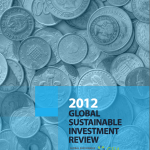The newly formed Global Sustainable Investment Alliance, consisting of a number of regional sustainable investment associations, published its first Global Sustainable Investment Review on Monday.
The report finds that, globally, at least US$ 13.6 trillion worth of professionally managed assets incorporate environmental, social and governance (ESG) concerns into their investment selection and management. This represents 21.8 percent of the total assets managed professionally in the regions covered by the report. And these figures represent a growing trend. From 2009 to 2011, the sustainable investment sector in Europe grew by 35 percent; in the United States by 22 percent and, from 2005 to 2012, the sector grew overall by a staggering 486 percent.
What is really interesting though is the regional and strategy split up of these numbers.

Regionally, ESG investing is dominated by Europe, the US and Canada, which combine for 96 percent of assets under management incorporating ESG factors. Amongst these three, Europe accounts for a whopping 64 percent, followed by the US with 27.6 percent. The other regions hardly play a significant role. Latin American, which does not yet have a sustainable investment forum, was not even part of the survey. This underlines that clearly, ESG investing does not yet play a strong role in emerging markets, but on the flipside it means that there is tremendous potential for growth in the years to come.
With respect to investment strategies, the most common strategies used for ESG investing identified in the report are as follows:
- negative screening, defined as exclusion from a fund or portfolio of certain sectors, companies or practices based on specific ESG criteria, accounts for US$ 8.3 trillion;
- integration, the systematic and explicit inclusion by investment managers of ESG factors into traditional financial analysis, accounts for US$ 6.2 trillion;
- corporate engagement and shareholder action, defined as a strategy that employs shareholder power to influence corporate behavior including through direct corporate engagement (i.e. communicating with senior management and/or boards of companies), filing or co-filing shareholder proposals, and proxy voting that is guided by comprehensive ESG guidelines, accounts for US$ 4.7 trillion;
- norm-based screening, the benchmarking of investments against minimum standards of business practice based on international norms, is valued at US$ 3 trillion;
- positive/best in class screening, the investment in sectors, companies or projects selected for positive ESG performance relative to industry peers, stands at US$ 1 trillion;
- and impact/community investing (Targeted investments, typically made in private markets, aimed at solving social or environmental problems) and sustainability themed investing (Investment in themes or assets specifically related to sustainability) account for US$ 89 and 83 billion respectively.
Negative screening is obviously the most basic form of including ESG factors into investment decisions, and it currently accounts for the biggest chunk of investment. However, other more sophisticated strategies also play a significant role and can be expected to grow further in importance in the future.

